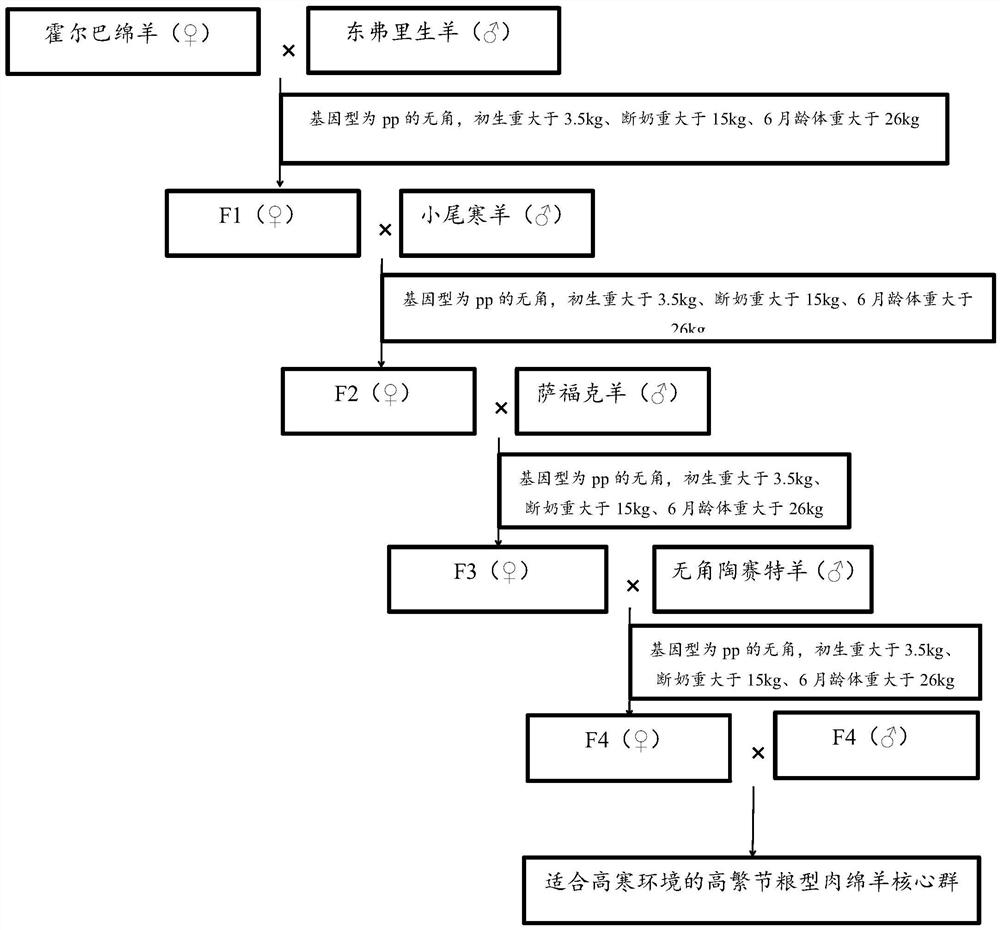A method for multi-trait selective crossbreeding sheep suitable for alpine environment
A technology of sheep and high cold, which is applied in the field of livestock breeding, can solve the problems of wasting forage, low utilization rate of double horns, and no new breeds of high-breeding and grain-saving meat sheep, etc., to achieve fast growth, stable genetic traits, and survival high rate effect
- Summary
- Abstract
- Description
- Claims
- Application Information
AI Technical Summary
Problems solved by technology
Method used
Image
Examples
Embodiment 1
[0041] (1) 900 hornless or small-horn, pure white, large-built Holba ewe sheep were selected as F1 generation hybrid female parents, and 30 hornless, pure white male East Fried sheep were selected as F1 generation hybrid male parents, Obtain 840 live sheep of hybrid F1 generation;
[0042] (2) From F1, select 500 female sheep whose horn type genotype is pp, pure white, newborn weight greater than 3.5kg, weaning weight greater than 15kg and 6-month-old body weight greater than 26kg to be the hybrid female parents of the F2 generation, without horns, 1000 pieces of frozen semen of pure white male Small-tailed Han sheep were the hybrid male parents of the F2 generation, and 470 live sheep of the F2 generation were obtained;
[0043] (3) Select 280 female sheep with FecB heterozygous type (B+), pure white, newborn weight greater than 3.5kg, weaning weight greater than 15kg, and body weight greater than 26kg at 6 months of age from the F2 generation. F3 generation hybrid female pa...
Embodiment 2
[0053](1) 900 hornless or small-horn, pure white, large-built Holba ewe sheep were selected as F1 generation hybrid female parents, and 30 hornless, pure white male East Fried sheep were selected as F1 generation hybrid male parents, Obtain 840 live sheep of hybrid F1 generation;
[0054] (2) From F1, select 500 female sheep whose horn type genotype is pp, pure white, newborn weight greater than 3.5kg, weaning weight greater than 15kg and 6-month-old body weight greater than 26kg to be the hybrid female parents of the F2 generation, without horns, Seventeen pure white male small-tailed Han sheep were the male parents of the F2 generation, and 470 live sheep of the F2 generation were obtained;
[0055] (3) Select 280 female sheep with FecB heterozygous type (B+), pure white, newborn weight greater than 3.5kg, weaning weight greater than 15kg, and body weight greater than 26kg at 6 months of age from the F2 generation. F3 generation hybrid female parent, 10 hornless, pure white...
Embodiment 3
[0065] (1) 900 hornless or small-horn, pure white, large-built Holba ewe sheep were selected as F1 generation hybrid female parents, and 30 hornless, pure white male East Fried sheep were selected as F1 generation hybrid male parents, Obtain 840 live sheep of hybrid F1 generation;
[0066] (2) From F1, select 500 female sheep whose horn type genotype is pp, pure white, newborn weight greater than 3.5kg, weaning weight greater than 15kg and 6-month-old body weight greater than 26kg to be the hybrid female parents of the F2 generation, without horns, Seventeen pure white male small-tailed Han sheep were the male parents of the F2 generation, and 470 live sheep of the F2 generation were obtained;
[0067] (3) Select 280 female sheep with FecB heterozygous type (B+), pure white, newborn weight greater than 3.5kg, weaning weight greater than 15kg, and body weight greater than 26kg at 6 months of age from the F2 generation. F3 generation hybrid female parent, 10 hornless, pure whit...
PUM
 Login to View More
Login to View More Abstract
Description
Claims
Application Information
 Login to View More
Login to View More - R&D
- Intellectual Property
- Life Sciences
- Materials
- Tech Scout
- Unparalleled Data Quality
- Higher Quality Content
- 60% Fewer Hallucinations
Browse by: Latest US Patents, China's latest patents, Technical Efficacy Thesaurus, Application Domain, Technology Topic, Popular Technical Reports.
© 2025 PatSnap. All rights reserved.Legal|Privacy policy|Modern Slavery Act Transparency Statement|Sitemap|About US| Contact US: help@patsnap.com



